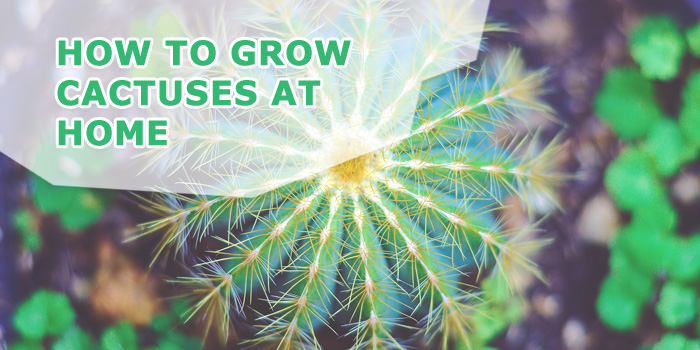
Succulent plants get into the florists’ radars due to their resilience to sudden temperature changes and low air humidity which is often the case in warm rooms during winter. If you wonder how to grow cactuses at home, count the peculiarities of the different species, as well as their development and blossoming rhythm.
Table of Contents
Types of cactuses
Cacti are defined in two separate basic groups according to the main differences in their origin and requirements to grow – desert and forest. Most cactuses belong to the desert group and originate from the warm half-desert areas of America.
- Cleistocactus;
- Cephalocereus;
- Lithops;
- Opuntia;
- Echinopsis;
- Echinocactus;
When creating a desert ecosystem – an unusual gardening decoration idea, some cactuses (especially the ones that dislike direct sunlight) can be grown together with others, faster-growing succulents that originate from the deserts and the mountains of the old world (alpine rose, eleven o’clocks, aloe, dracaena).
This whole thing, however, should be coordinated with the yearly and seasonal cycles in the growth and development of concrete plants.
Many cactuses take water in over the span of many years from the environment through their underground root system, as well as with their upper parts in the early morning when water condenses.
In order to protect themselves from being eaten, some cactuses developed physical (thorns) or/and chemical (building up of toxic or psychoactive compounds) defence mechanisms.
The cactus fruits usually have bright colouring and a relatively higher number of alkaloids due to their low water contents. Apart from that, cactus fruits contain a certain amount of carbohydrates.
In the Rio Grande region and the Sonora desert, there are animal species which feed exclusively on the psychoactive cactuses’ fruits without any major negative influences on their normal life cycle.
Need a professional gardener?
Enter your postcode to view our rates and availability in your area.
For questions about the services we offer visit our main site or you can always call us at 020 3404 4881
How to grow cactuses at home
How to select the best light and temperature conditions for cactuses
Place your cactus collections in the sun. This could be window sills facing south-west, with provided access to enough fresh air. In order to have beautiful blossoms, place the cactuses in a dry and cold place (around 10°C) and water rarely during winter.
Arm yourself with patience
Cactuses grow and develop extremely slow. While other plants with similar size complete their life cycle within one or a couple of years, some cactuses (Lophophora) can live a decade or two before blossoming for a short time and giving fruit.
During winter, the cactuses do not need much warmth. However, if you place them in a heated room, this negatively impacts their blooming cycle. They feel well in a greenhouse, as well as in a sunlit room, but they can be grown even if the lighting is artificial.
Some species can even grow annually outside on the open air, directly on a small hill of gravel, sand and stones in the corner of your garden.
How to choose the right garden spot for the cactuses
In a moderate climate country, the best place would be a room or a terrace with a southern view. Some species, on the other hand, do not like direct sunlight and need a bit of shade or a room facing west. If you have only a north-facing room, though, you might need to install artificial lighting. In order to create the perfect garden spot for the cacti, you can do the following:
- Make a small hill of sand, gravel and soil;
- Surround it with stones;
- Choose the most sunlit part of the garden for the purpose;
- Build the cacti retreat next to a wall facing south, bathed by the sun from dawn until dusk.
When growing a cactus in a northern or western room, the plant begins to bend towards the light, and if you spin it around every week, it will gain a spiral shape.
The cactuses endure temperatures in the amplitude of 8 to 38 °C without any problems, however, they can also endure -5 and 45°C, for a while. When they grow outside, the choice of species is limited, but some families (Trichocerus, Ophunta, Coryphantha) are appropriate for the purpose.
How to make cactus soil
Mix the following:
- ½ small gravel;
- ¼ heavy grain sand;
- ¼ peat or forest soil;
- 1 full tbsp of bone meal;
- fertiliser;
- 3 tsp of gypsum
- 1 tea cup of potassium-rich granite sand;
- 3 tbsp of crushed soap stone (for each 4.5 litres of soil);
If the mixture turns to be great, with enough phosphorus and potassium, the cactus can blossom in about five years.
How to choose the proper cactus pot
Ceramic pots work best with cacti. However, you can work on the pot comfortability and add a few tweaks:
- You can choose either a plastic or a clay pot – both work well for cacti.
- If the sort of cactus you are growing has a slow blooming rate, it will feel better in a clay pot or a cement box.
- Place a layer of gravel on the bottom;
- Leave an opening for drainage purposes;
How to water cacti
Cactuses do not need a lot of water during winter – just on the warmer winter days. The cactus can endure temperatures below zero. During spring and autumn you can water them once every 10 days.
However, do that only when it’s not raining. During summer – once every 4-5 days will be enough. If the pot is plastic, or the cactus is already large in size, the watering should be done twice less.
The best tool for the purpose is a watering can. Some thornier species, however, react better at watering with a spray bottle.
If the water contains lots of limescale, you will observe white residue on the plant. Use rainwater in such a case.
How do cactuses reproduce
Cactuses reproduce most commonly and most easily in a vegetative way, spontaneously or just after their body sustains damage. Then a bud grows out of the broken thistle. You can break thumb-sized thistles and replant them, too.
Cactuses can continue to grow for 5 up to 25 years before they even start flowering. They form seeds even more rarely than that. The easiest option is to use the vegetative way of reproducing, by rooting a branch of the cactus.
How to replant cactuses
- Use soil mix for potted flowers, mixed with the same amount of well-washed sand.
- To prevent over-moisture and rotting, place a layer of crushed stone in the drainage plate;
- Replant the cactuses during spring in a pot, slightly larger than the previous one;
- If you want your cactus to bloom, the pot should be a bit smaller;
How to fertilise cacti soil
Add liquid fertiliser every ten days. It is best to use a fertiliser with a high amount of potassium carbonate and phosphorus. This will stimulate the formation of beautiful flowers. Bone meal fertiliser is an appropriate organic option for the cactuses.
Need a Gardener?
Enter your postcode to view our rates and availability in your area.
For questions about the services we offer visit our main site or you can always call us at 020 3404 4881



